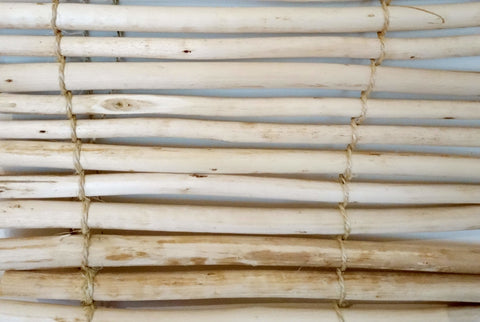50 Days with a Cotton Tree – Hibiscus tiliaceus Oct 2015
From the archive of Annies Workroom website 2013-2021
An excerpt from my exhibition The Notion of an Ordinary Yarn
Noosa Regional, Queensland, Australia 22nd October to 6th December 2015
The journey to make string has taught me so much about being with plants, and the absorption of process. I have delved into string, cordage, twine a number of times in the last few years. It is a subject that seems to repeat itself in fibre weaving classes. There are many techniques and twists so to speak, and string is as old as civilization, so I guess it goes to prove it is the simple things in life that can give the most pleasure.

Source http://www.fao.org

Harvested awaiting processing
The Cotton Tree, as a weaving fibre was introduced to me by Rene Bahloo (Weavery) at a workshop run at Landcare. The traditional method from what I can gather included stripping the inner bark and then chewing it, or placing it in a running creek or in the ocean to clear it of the slimey mucus substance (this is called retting the fibre). I found that because I wanted to make a large quantity of string I needed to find a different method. After searching online and asking people, I found an article that gave details of boiling with ash (alkaline) to break down the mucus, then rinsing, I added beating with a mallet and combing, a method taught in a class at Fibre Arts Ballart by Tim Johnson (a European basket weaving artist).

Inner Bark Separated and Drying

Boiled, Beaten, Combed and Dried
The process of experimentation took weeks, I fell in love with the cotton tree, the wood is light in colour, soft and beautiful. I had to let go of my ideas of fine string, the resulting cordage was more like fine rope. The cotton tree consumed me for two months. I used the wood to make the frames for the work, which added another layer of process, how to clean, strip and dry the wood to avoid spoiling from mould.

Tools used to process wood

Wood scraped and drying
I now have a familiarity with the plant, I know how it feels, smells and its physical properties. I was able to recognise the drift wood washed up on the seashore, and can identify the plant as I drive by coastal roads. We now have a connection, that goes beyond words printed in a book, or read online, it is a less tangible connection based on senses and time.
Resources and Further Reading
Identification and Landscape notes
Fibre Arts Australia Workshops
Rene Bahloo Weavery Workshops & Fibre Tours
India Flint Teacher of String and Dyeing
Your email address will not be published. Required fields are marked *